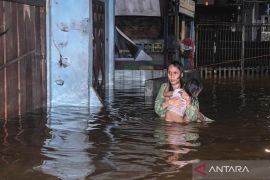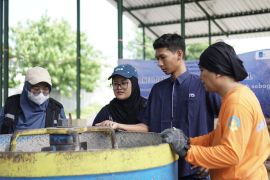The country has four disaster clusters: geology and volcanology (volcanic eruptions, earthquakes, and tsunamis), hydro-meteorology I (forest fires and drought), hydro-meteorology II (flash floods, landslides, and coastal abrasion), and non-natural disasters (waste, epidemics, and technological failures).
The National Disaster Mitigation Agency (BNPB) has reported that 2,931 disasters displaced 8.26 million people in Indonesia between January 1 and December 19, 2021.
Last year’s disasters claimed 654 lives, rendered 93 people missing, and left 14,105 others injured.
The disasters comprised 1,236 floods, 746 extreme weather incidents, 595 landslides, and 265 forest and plantation fires.
During the first week of January 2022, the agency recorded 68 natural disasters comprising 38 floods, 16 extreme weather events, 12 landslides, 1 forest fire, and 1 tidal wave.
The disasters left 7 people dead, 15 people injured, and 140,620 others affected and displaced.
Head of the BNPB, Lt. Gen. Suharyanto, has appealed to all parties to increase resilience in dealing with natural and non-natural disasters.
Located in the world's volcanic belt, flanked by two oceanic and continental plates, Indonesia's volcanic tectonic and hydro-meteorological activity is the highest in the world, he said.
The country, which only experiences dry and rainy seasons, entered the rainy season in September 2021, which is expected to peak in January and February 2022, a circumstance that usually triggers flooding in several regions.
Since late last year, floods have been reported in several areas in the provinces of West Java, East Java, Central Java, Jakarta, Aceh, Papua, South Kalimantan, North Kalimantan, West Kalimantan and East Kalimantan, and West Sumatra, among others.
Flooding in Jember district, East Java province, on January 9, 2022, claimed two lives and rendered one resident missing.
BNPB spokesperson Abdul Muhari informed in a press statement that the floods submerged the villages of Kaliwates, Sempusari, and Mangli in Kaliwates sub-district; Rambi Puji and Ramigundam villages in Rambi Puji sub-district; and Kemiri and Suci villages in Panti sub-district, Jember district.
The flash floods swamped 440 houses, 3 places of worship, and 2 shops, and affected 440 families comprising 1,668 people, he said. However, the disaster did not trigger evacuations, he added.
Furthermore, the Indonesian people have been urged to remain alert for hydro-meteorological disasters in 2022.
"While the rainfall is estimated to be lighter as compared to 2021, the government and people should still be wary of potential hydro-meteorological disasters," head of the Meteorological, Climatological, and Geophysical Agency (BMKG), Dwikorita Karnawati, said.
Rainfall above the normal rate has been forecast in several regions across the country this year, she noted.
Above normal rains are projected in January in regions such as Central and North Sumatra, East and North Kalimantan, West Java, half of Sulawesi, East Nusa Tenggara, Maluku, and Papua, she informed.
This weather forecast is also for half of Sumatra, half of Java, East Kalimantan, North Maluku, and Papua for the month of February, she said.
North Sumatra, Java, North Kalimantan, Sulawesi, Maluku, North Maluku, and half of Papua are expected to experience above-normal rainfall in March, she added.
"The negative and positive effects caused by the climate should still be mapped out. Above-average rainfall could be utilized to ensure meeting the needs for water resources, farming, and the forestry sector," Karnawati advised.
To address these negative impacts, the regional governments and the public should be wary, adopt precautionary measures, and conduct mitigation to avoid and reduce the risk of hydro-meteorological disasters, she added.
Considering the country’s vulnerability, Dr. Indra Permanajati, an academic from Jenderal Sudirman University (Unsoed), has asked local governments to intensify mitigation programs through the establishment of disaster-resilient villages.
"In 2022, the establishment of disaster-resilient villages must be a priority program of the regional governments through disaster management agencies in each region," he remarked on January 17, 2022.
Permanajati, who is also the coordinator for the Geological Disaster Mitigation Center of Unsoed, said the establishment of disaster-resilient villages should be prioritized in disaster-prone areas.
"Because the disaster-resilient village program will increase the community's capacity for dealing with disasters. This capacity-building will assist efforts to reduce disaster risk," he explained.
The mitigation or disaster risk reduction program will require the active role of the community to run well, he added.
"Human resources, as part of disaster management, have a very significant role because strong human resources will support mitigation efforts, especially in disasters caused by humans. For example, flooding that is caused by the stagnant flow of rivers due to piles of garbage," he explained.
Besides, people still need to be provided an understanding of how they can protect themselves from disasters, he added.
"Hence, the disaster-resilient village program must become a mandatory program that must continue to be developed. The concept of disaster management now must start from a strong local community," he said.
Yanto, Ph.D, hydrology and water resources expert from Jenderal Soedirman University, advised that the Indonesian government should continue to make flood mitigation a priority program in 2022.
In 2021, the number of natural disasters, such as floods, was still relatively high in the country, he noted here on Friday.
According to the expert, most of the 3,078 disasters recorded by BNPB in 2021 were caused by rain.
"Of the total figure, 89 percent were caused by fluctuations in rainfall, either in the form of floods, extreme weather, landslides, or droughts. Floods continued to dominate the number of disasters in Indonesia, with 42 percent of all recorded disasters," he remarked.
To this end, Yanto opined that programs that strengthen flood mitigation efforts should be prioritized in 2022.
He also highlighted the importance of creating maps of flood-prone areas in an effort to strengthen mitigation capacity.
"With the existence of flood-prone maps, the location services on people's smartphones can be used to convey information directly when there are people who enter flood-prone areas," he remarked.
Related news: BMKG urges cautiousness against hydrometeorological disasters in 2022
Related news: BNPB asks four provinces to remain alert for La Nina
Related news: BMKG warns of potential hydrometeorological disasters
Editor: Rahmad Nasution
Copyright © ANTARA 2022












